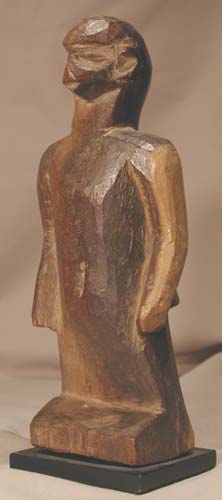Zulu Wooden Sculpture of a Man, 19th Century CE - 20th Century CE
Wood
4 x 10
PF.4537
Further images
Many African tribes have a tradition of wood sculpture which goes back hundreds of years. The Zulu are an exception, and when one of their statues is found it is...
Many African tribes have a tradition of wood sculpture which goes back hundreds of years. The Zulu are an exception, and when one of their statues is found it is an exciting discovery. Why some groups of people produce great quantity of masks, for instance, and others, of similar origins, produce none is a perplexing question. This brings up the issue of artistic motivation. In African cultures, most works of art are created because of the demands of society - for dance rituals, initiation ceremonies, or in some cases, for propaganda purposes. When seeing an extraordinary object such as this wooden sculpture we must ask ourselves, did an artist create this for his own satisfaction with no other motive involved?
Pure abstraction and minimalism are the essence of this remarkable piece. Yet, such terms are Western points of reference and an African sculptor is unlikely to have created this object with the intention of wanting to make something different from other artists. It is also unlikely that he referred to works of the past to guide him in a new direction. Innovation for its own sake is a European/American phenomenon, and though exciting in its own context, it would have little meaning to an African artist. Rather, he worked in a different direction, focusing on an idea instead of attempting to redefine an image. The Zulu artist carved the wood carefully in order to discover something primal and deep within, perhaps connecting within feelings set down by oral tradition or the collected imagery of his people. When the right moment was reached the sculptor could go no farther; the object had achieved its power and to remove one more fragment would lessen its overall intensity. The finished work is then something massive, which reaches beyond its size to encompass indefinable aspects that are indeed larger than life.
Pure abstraction and minimalism are the essence of this remarkable piece. Yet, such terms are Western points of reference and an African sculptor is unlikely to have created this object with the intention of wanting to make something different from other artists. It is also unlikely that he referred to works of the past to guide him in a new direction. Innovation for its own sake is a European/American phenomenon, and though exciting in its own context, it would have little meaning to an African artist. Rather, he worked in a different direction, focusing on an idea instead of attempting to redefine an image. The Zulu artist carved the wood carefully in order to discover something primal and deep within, perhaps connecting within feelings set down by oral tradition or the collected imagery of his people. When the right moment was reached the sculptor could go no farther; the object had achieved its power and to remove one more fragment would lessen its overall intensity. The finished work is then something massive, which reaches beyond its size to encompass indefinable aspects that are indeed larger than life.







